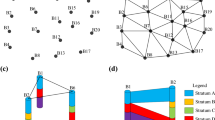Abstract
In the past three-dimensional geological modeling process, only vertical geological data, i.e. borehole or profile drawn from borehole, was used as the modeling data source. However, the plane geological map either does not participate in the modeling at all, or only serves as a reference data in the modeling process, and its role is not fully played. In view of the appeal, this paper puts forward a plane section modeling method based on multiple constraints. This method combines the vertical geological data and the horizontal geological data to participate in the modeling work. The surface part of the 3D geological model constructed by this modeling method is completely consistent with the plane geological map. In addition, there are both vertical data source and horizontal data source, which greatly improves the accuracy of the model. In this paper, taking the kangyangju area of Huaying Mountain in Guang’an City as an example, using the plane section modeling method with multiple constraints, the three-dimensional geological model construction of kangyangju area is carried out, which proves that the method is reliable and useful, and is worth popularizing.








Similar content being viewed by others
References
Apel M (2006) From 3d geomodeling systems towards 3d geosciences information systems: data model,query functionality, and data management. Comput Geosci 20 (32): 222–229
Brande S, Schneider S, Perrin M et al (2005) Automatic building of structured geological models. J Comput Information Sci Eng ASME 5(2):138–148
Divya Priya B, Dodagoudar GR (2018) An integrated geotechnical database and GIS for 3D subsurface modelling: application to Chennai City, India. Appl Geomatics 10:47–64
Hao M, Wang D, Deng C et al (2019) 3D geological modeling and visualization of above-ground and underground integration ——taking the Unicorn Island in Tianfu new area as an example. Earth Sci Inf 12(4):465–474
He M, Xueyuan L, Bin L et al (2007) Three-dimensional modeling of borehole data cored from engineering rock mass. Front Architect Civil Eng China 1:334–339
He D, Duan XG, Li SM et al (2019) Impact of depositional environment and diagenesis on the upper Triassic Xujiahe tight-sand reservoir in Guang’an area, Central Sichuan Basin, SW China. Carbonates Evaporites 34:219–232
Hofmayer F, Kirscher U, Sant K, Krijgsman W, Fritzer T, Jung D, Weissbrodt V, Reichenbacher B (2019) Three-dimensional geological modeling supports a revised Burdigalian chronostratigraphy in the North Alpine Foreland Basin. Int J Earth Sci 108:2627–2651
Jia ZB, Cao K, Yang ZQ (2017) An optimized 3D geological modeling method based oil borehole data. Sci Technol Eng 17(17):178–183 (in Chinese)
Liu H, Cao TT, Qi MH et al (2019) Reservoir characteristics of Longtan Formation shale gas in Huayingshan area,eastern Sichuan Basin. Nat Gas Geosci 30(1):11–26 (in Chinese)
Song RB, Qin XQ, Tao YM et al (2019) A semi-automatic method for 3D modeling and visualizing complex geological bodies. Bull Eng Geol Environ 78:1371–1383
Velasco V, Gogu R, Vázquez-Suñè E, Garriga A, Ramos E, Riera J, Alcaraz M (2013) The use of GIS-based 3D geological tools to improve hydrogeologicalmodels of sedimentary media in an urban environment. Environ Earth Sci 68(8):2145–2162
Wang Y, Zhang XY, Chen WJ (2017) 3D modeling method and its application of engineering geology based on multi-source drilling data. China Mining Magazine 26(2):387–390 (in Chinese)
Wu X (2017) Building 3D subsurface models conforming to seismic structural and stratigraphic features. Geophysics 82(3):21–30
Wu Q, Xu H, Xukai Z (2005) An effective method for 3D geological modeling with multi-source data integration. Comput Geosci 31(1):35–43
Yao HB, Gao F, Yu SG et al (2017) Construction risks of Huaying mount tunnel and countermeasures. Front Struct Civ Eng 11:279–285
Zhu L, Chengjuan Z, Mingjiang L et al (2012) Building 3D solid models of sedimentary stratigraphic systems from borehole data: an automatic method and case studies. Eng Geol 127:1–13
Acknowledgments
This research was supported by the geological survey project of China Geological Survey Bureau, Ministry of natural resources, “comprehensive geological survey of resources and environment in Guang’an, Sichuan” (DD20190524).
Author information
Authors and Affiliations
Corresponding author
Additional information
Publisher’s note
Springer Nature remains neutral with regard to jurisdictional claims in published maps and institutional affiliations.
Communicated by: H. Babaie
Rights and permissions
About this article
Cite this article
Hao, M., Li, M., Zhang, J. et al. Research on 3D geological modeling method based on multiple constraints. Earth Sci Inform 14, 291–297 (2021). https://doi.org/10.1007/s12145-020-00554-6
Received:
Accepted:
Published:
Issue Date:
DOI: https://doi.org/10.1007/s12145-020-00554-6




